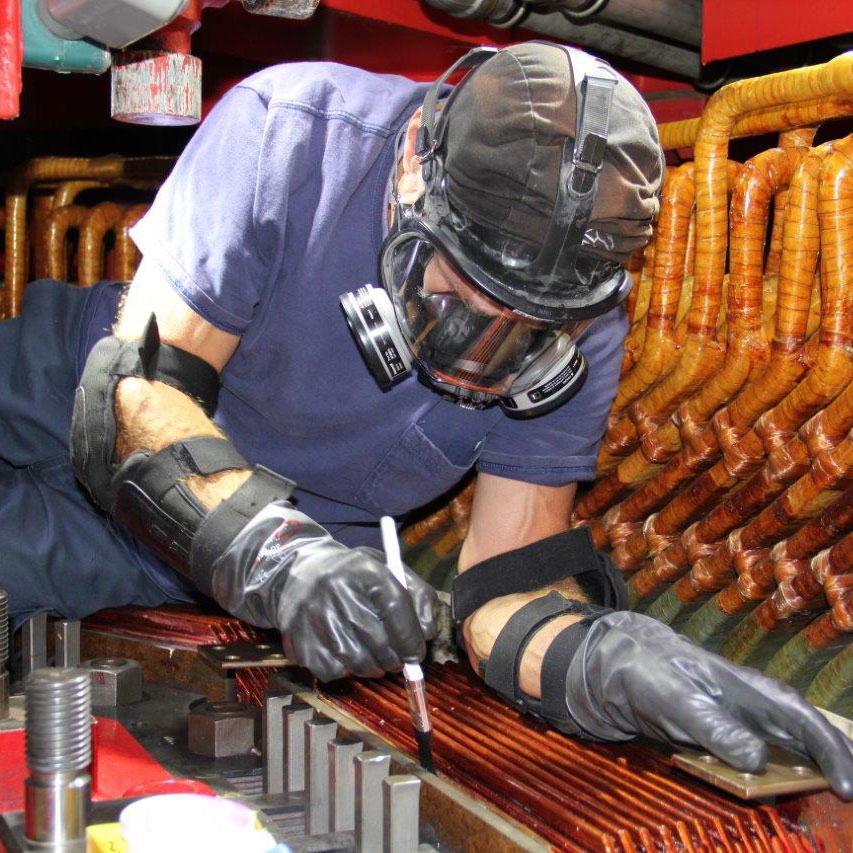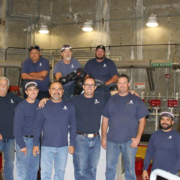You might not think ‘baking skills’ would come in handy to fix a recent problem at the Lake Hodges Hydroelectric and Pump Station Facility. But those skills, along with initiative and ingenuity, were demonstrated by San Diego County Water Authority staff as part of the creative and complex repair.
The facility connects the City of San Diego’s Hodges Reservoir with the Water Authority’s Olivenhain Reservoir. The connection provides the ability to store up to 20,000 acre-feet of water at Hodges for emergency use.
The Lake Hodges Hydroelectric and Pump Station Facility moves water between Olivenhain and Hodges, and is able to generate up to 40 megawatts of energy on demand, helping to manage electrical demands throughout the County. It also generates revenue and helps offset energy costs.
Ground fault alarm alerts staff
A ground fault alarm on August 25, 2019 alerted staff to a potential problem with Unit 2, one of the facility’s two 20-MW pump-turbine units. A series of tests and inspections by staff with the Water Authority’s Rotating Equipment team discovered the insulation on the copper bus bars of the generator’s rotor were worn and damaged. The bus bars are part of a system that provides DC power to the 12 electromagnets which surround the outer surface of the pump turbine unit’s rotor.
The rotors are designed to spin at 600 revolutions per minute and it’s the rotor’s electromagnets acting upon the stators windings that generates power. The electromagnets are connected together by copper bus bars located on top of the rotor and the bus bars are secured to the rotor by clamping plates and rim studs. The bus bars are insulated to ensure the copper does not touch any other metal surface and cause an inadvertent ground fault.
“Although a single ground fault may not damage the pump-turbine unit, it may prevent it from starting, if two ground faults were to occur, significant damage to the pump-turbine unit would occur and would also be an extreme danger to anyone within the facility,” said Jim Fisher, Water Authority director of operations and maintenance.
Creative solutions and ingenuity save time, money
Among various factors, the primary cause of the insulation failure was determined to be improper wrapping and curing of the insulation during initial installation.
Water Authority staff developed solutions and also took on the repair tasks in September. By doing the work in-house, the Water Authority avoided a more extensive outage due to long lead times required by contractors and vendors to perform the same work, saving time and money.
“Staff did an excellent job maintaining the operation of Unit 1 while making the repairs to Unit 2,” said Fisher, “which allowed the Water Authority to avoid a total shutdown and loss of all revenue during this period.”

Initiative and ingenuity by San Diego County Water Authority staff led to a creative repair solution at the Lake Hodges Hydroelectric and Pump Station Facility. Photo: San Diego County Water Authority
‘Baking skills’ come in handy to create new bus bars
New copper bus bars were fabricated, and each had to be precisely wrapped by 5 different types of insulating tape materials. This wrapping process alone took approximately 8 hours per bus bar. The bus bars were then baked for ten hours within newly designed and fabricated aluminum molds to ensure proper pressure was applied to the insulation layers during the baking and curing process.
Staff efficiently re-purposed and utilized an oven that had been retained from the San Vicente Dam Raise Project to perform the baking. The Rotating Equipment team’s efforts produced excellent quality results which would have been difficult even for a vendor to meet. The newly insulated bus bars were re-installed, and the unit has been operating safely and without issues.
“The initiative, ingenuity, and highly technical skills and knowledge of our staff were once again on display throughout the repairs,” said Fisher. “Their dedication, talents and outstanding efforts continue to ensure the Facility’s efficient and safe operation.”
Unit #2 was tested and placed back into service on November 17, 2019.
Along with the bus bar insulation and curing process repair, staff also performed many other highly technical, innovative and precise processes to complete this repair work.

 Sweetwater Authority Logo 2019
Sweetwater Authority Logo 2019


